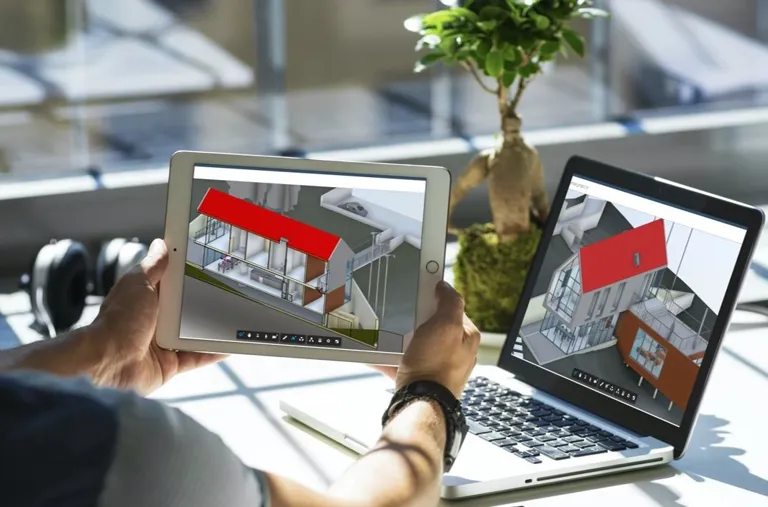The benefits of digital data and information management in the early phases of a construction project
In the architecture and construction industry, the initial phases of a project – such as drawing, design and material selection – are crucial for ensuring the ultimate success of the project.

It is during these early stages that the foundations for the aesthetics, functionality and sustainability of the project are laid. The integration of digital information management(DIM) systems, such as iBinder, with design tools such as CAD and BIM, plays a key role in optimising these processes, thereby ensuring that projects not only live up to the vision but are also implemented efficiently and cost-effectively.
Optimising the design process with DIM
DIM systems like iBinder enable a seamless and efficient design process by providing a centralised platform in which all design-related data and documentation can be stored and managed. This includes initial sketches, detailed drawings, 3D models and material specifications. By having all this information available in one place, architects and designers can work and collaborate more effectively, which results in a faster and more informed decision-making process.
Improved coordination and choice of materials
One of the most time-consuming steps in the early phases of a construction project is the coordination between different disciplines such as architecture, structural design and MEP (mechanical, electrical and plumbing). DIM-connected BIM tools enable an integrated design process in which all parties can collaborate in real time, thereby reducing the risk of conflicts and costly changes later in the project.
In terms of material selection, DIM systems can be linked to databases to provide a detailed overview of the available materials, as well as their costs, sustainability assessments and delivery times. This information is essential for making informed choices that balance the aspects of aesthetics, functionality and budget.
Effective use of early design models
By using DIM systems integrated with BIM tools, early design models can be utilised to carry out various analyses such as energy performance, sunlight analysis and room acoustics. This ability to simulate and analyse a building’s performance at the initial stages enables design optimisation that can lead to significant cost savings and improved building performance.
An architectural team working with the design of a sustainable office complex can quickly experiment with different façade materials and glass types to optimise the building’s energy efficiency and working environment. Each option can be analysed in terms of cost, aesthetics and environmental impact, which provides an informed basis for decisions. This process, which can be supported by real-time data and collaboration features in the DIM system, promotes innovation and efficiency right from the very start.
Improving client communication and feedback
DIM systems also facilitate more dynamic and interactive communication with clients during the initial phases. Clients can access design models and simulations via cloud-based platforms, even if they are using mobile phones, which enables them to provide direct feedback and make informed choices. This transparent and inclusive process strengthens client relationships and ensures that the end result more accurately reflects the client's vision and expectations.
Management of changes and revisions
Another critical area in which DIM demonstrates its value is in the management and communication of changes and revisions, which are often unavoidable in the early stages of construction projects. DIM systems allow project teams to quickly update drawings, models and documentation to reflect changes, and also automatically notify all stakeholders. This agility reduces time delays and costs associated with late changes.
Integration of sustainability targets in the design phase
In line with the growing focus on sustainability and green buildings, DIM systems enable a more integrated approach to incorporating sustainability targets into the early design phases. Using data-based analysis, teams can evaluate different design options to maximise energy efficiency, reduce the carbon footprint and ensure use of sustainable materials, thereby creating buildings that contribute to environmental, economic and social goals.
Future potential and development
Advances in technology continue to expand the capabilities of DIM systems, including the potential for even greater integration with AI and machine learning to further optimise design and decision-making processes. Future DIM systems are likely to offer even more advanced tools for predictive analysis and automated design, thus further improving efficiency and innovation in the early stages of construction projects.
The initial stages of a construction project place high demands on precision, cooperation and information management. By integrating digital information management with advanced design tools, project teams can make these critical processes more efficient. This leads not only to a more streamlined design phase, but also to construction projects that are more in line with customer needs, more sustainable and more cost-effective. DIM thus provides an invaluable resource for everyone involved in the early stages of construction projects, which enables the creation of buildings that are not only aesthetically pleasing but also functional and sustainable over time.
Modern cloud-based DIM systems such as iBinder are not just tools for data and information management, but rather a catalyst for change that is driving the industry towards a more sustainable and innovative future.
The benefits of using iBinder at an early stage
-
Offers easy and seamless transitions between the phases of construction projects, for example from early stages to design and then production.
-
If you have a lot of projects currently ongoing, you can see which ones are in each phase of the construction process; early stage, design, production, warranty phase, etc.
-
Information management for the project is kept together right from the start, instead of being scattered across various emails and different cloud storage systems. The history is clear, which is particularly important in long projects.
-
In iBinder it is easy to upload, review and show BIM models directly in your binders. You can view the entire BIM model or limit it to specific areas.
-
Documents and information are linked to communication, so it is easy to see which users have accessed and seen what.

